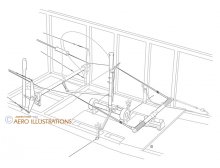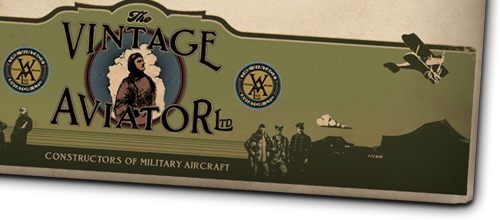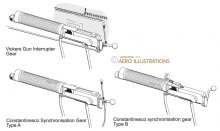You are here
RE.8 History
“The Re8 was a two-seater biplane that was originally built as a replacement for the vulnerable and outmoded Be2. The Re8 was designed for stability and speed enabling it to be ideal for reconnaissance and spotting enemy artillery and positions. Unlike the Be2 the Re8 had a reputation for being difficult to fly and was commonly disliked by pilots and staff of the Royal Flying Corps.”
The RE8 was intended to become the mainstay of the RFC’s reconnaissance force. Its service debut was far from encouraging and it rapidly gained a reputation as a death trap. Some maintain that the RE8 has been unfairly maligned. Whatever the truth, it was a remarkable aeroplane, if only because of the huge numbers built (over 4000), and the fact that its operational history spanned the major period of the First World War.
design and performance
Known colloquially as the 'Harry Tate', after a popular music hall performer, the RE8 was designed around specifications drawn up in late 1915 for a two-seater corps reconnaissance aircraft to replace the BE2c. The prototype flew in June 1916 and it entered service late that year. Due to delays in the development of a replacement type, the RE8 was still in production and frontline service at the end of the war. No.52 Squadron RFC became the first squadron equipped with the type in November 1917. It was plagued by so many fatal accidents that by February the type was being exchanged for the BE2. The aircraft was described as a 'death trap’ and 'an incinerator of pilots'. In April 1917, 59 Squadron suffered the loss of all six aircraft of a patrol in a skirmish with Jasta 11 that only lasted minutes.
Even the Air Board was concerned about the suitability of the RE8. The Minutes of the Air Board Meeting of 23 May 1917, it was recorded that “though the RE8 had been made safer it would never be as safe as the BE machine”. Earlier that same month both General Brancker and General Brooke-Popham had expressed the opinion that it had been had been a mistake to give up the BE in favour of the RE8. One pilot described the RE8 as 'more like flying a steam roller than an aeroplane'. The aircraft was 'heavy' on turns and many of the early accidents resulted from 'swinging tail' caused by excessive use of the rudder during a turn. All that was necessary to correct this tendency was to increase the amount of bank and centre the rudder. However, as the tail swung into the slipstream, aerodynamic forces worked against the pilot's efforts. The pilot’s notes recommended centralising the rudder “without putting on sufficient pressure to break anything”.
As a result of the criticism a larger fin was introduced during production. Training squadrons were known to increase the fin size even further, sometimes by fitting a modified BE2e fin. With the engine idling and the aircraft gliding, such as on an approach to land, the machine would begin to lose speed rapidly below 65 mph, stalling at less than 50 mph. Additional drag, such as that generated by the rudder in a turn or even by the observer standing up in his cockpit, could be sufficient to reduce the aircraft's speed to the point of stall, of which there was very little warning. Idiosyncratic flying characteristics were, of course, fairly common amongst the aircraft of the period. The early accident rate can be attributed to the manner in which it was introduced into service rather than its handling characteristics. Most pilot training during 1916/17 was rushed and inadequate. The pilots of No.52 Squadron were inexperienced and the more powerful RE8 had different flying characteristics to the BE2 it replaced.
There is ample evidence to show that an experienced pilot could fly the RE8 without any difficulty. A pilot from No.1 Squadron noted that “It came to us with a reputation for spinning…but that was not our experience, nor that of No.3 Squadron.” The cruising characteristics of the RE8 were quite good. It was extremely stable and, with the correct adjustment of the tailplane incidence, the machine could be flown 'hands off'. Despite the Air Board's concern, the aircraft was able to carry out reconnaissance, photographic and artillery observation work quite satisfactorily. When flown by a good crew, the RE8 could defend itself against attacks by two or even three enemy fighters.
Service

Three squadrons of the Australian Flying Corps, Nos 1, 3 and 7 (Training), were equipped with the RE8. No.3 Squadron accrued almost 10,000 hours of war flying in France between September 1917 and November 1918. Its crews were renowned for their skill and aggression in combat, accounting for 51 enemy aircraft destroyed, driven down out of control or damaged, for the combat loss of only 11 of their own machines.

With modifications and further training, the Re8 gave reasonably satisfactory service, although it was never considered an outstanding combat aircraft.From 1916 to 1918 over 4,000 of these craft were produced and they saw service in most theatres including Russia, Italy, Palestine, Mesopotamia and the Western Front.

The cockpit layout of the RE8 was typical for the day, with the possible exceptions of the RL tube and the Very pistol fitted on the starboard side. Additional equipment and modifications were often carried out at squadron level and for this reason there were variations between individual aircraft.
The pilot usually operated the camera or, when directing artillery fire, the Morse key. It was found on operations that the observer was best utilised scanning the sky for enemy aircraft. Note that emergency flying controls for both rudder and elevator were fitted for the benefit of the observer, but there was no such facility for aileron control.
The Vintage Aviator Ltd would like to thank Juanita Franzi "AERO ILLUSTRATIONS" for her detailed cutaway drawings and historic research of this remarkable aircraft.
General characteristics
Crew: 2 (pilot & observer/gunner)
Length: 27 ft 10 in (8.5 m)
Wingspan: 42 ft 7 in (12.98 m)
Height: 11 ft 4 in (3.47 m)
Wing area: 389 ft² (35.07 m²)
Empty weight: 1,577 lb (717 kg)
Max takeoff weight: 2,862 lb (1,301 kg)
Powerplant: 1× Royal Aircraft Factory 4a air-cooled 12-cylinder inline engine, 150 hp (112 kW)
Performance
Maximum speed: 102 mph (164 km/h)
Service ceiling: 13,500 ft (4,115 m)
Rate of climb: 22 minutes to 10,000 ft (3,045 m)
Armament
1 x .303 in (7.7 mm) forward-firing Vickers gun
1 or 2 x .303 in (7.7 mm) Lewis guns in rear cockpit
up to 224 lb (102 kg) bombs



